Project progress
Ready For Railex
Other than five guest locos and Happy Hour visitors, the Far North line-up at Railex will look like this.
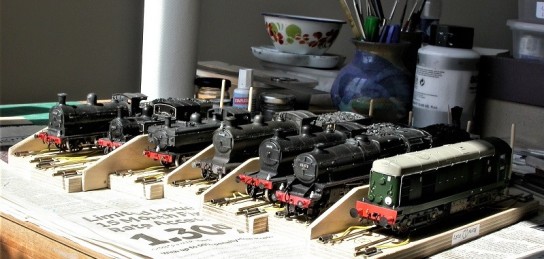
All locos are lettered and numbered, they have the correct lamps for their duties, the driver and/or fireman are on the footplate, and there’s coal or oil in the tender, bunker or tank.
My latest loco for Railex, the recently painted and numbered ex-GWR 1649, had a quick run yesterday evening before I started to pack up the layout for Railex.
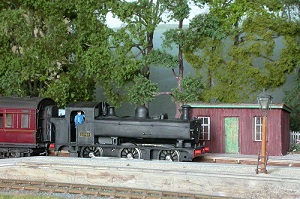 1649 steams into Culrain with the Dornoch coach
1649 steams into Culrain with the Dornoch coach
And that’s it.
Read Full Post | Make a Comment ( 1 so far )Pannier Progress
The first proper trials of 1649 (still with masking tape around the panniers and plastic sleeving “crankpin nuts”) took place at the end of last month on “Little Stoke”, Allan Smith’s fine, freelance layout set appropriately somewhere on the ex-GWR main line in the West Country.
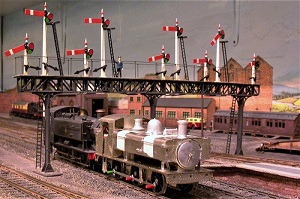 West Country panniers
West Country panniers
Using phosphor bronze wire pick-ups on the backs of the wheel rims, as Allan had shown me on 54458, 1649 was still a hesitant runner. That is until he showed me how to fine tune the pick-ups with a pair of very finely-pointed tweezers. With power to the motor, 1649’s twin beam and rocking axle compensation was able to do its job. 1649 has rather more side-play on the middle drivers than I would normally have, allowing it to successfully negotiate Little Stoke’s much tighter curves and points than on Kyle of Sutherland.
The next step with the chassis was to improve and simplify the wiring. I used two-pin micro-connectors for the first time with two sets of red and black wires going from the motor to pick-up pads at the front and rear of the chassis. I found the 10/0.1 wiring quite bulky (1649 has a very small diameter boiler), especially with a micro-connector for each pick-up pad. The wires were also over long at this trial stage and spilled over into the cab and bunker. Allan showed me how he used stripboard to wire up some of his locos. 1649 now has red/black wire pairs from each pick-up pad soldered into a single piece of stripboard bolted to the chassis directly under the firebox. A single red/black pair of wires from the motor now goes to a micro socket, without intruding into the cab or bunker, and pops onto the pins of a micro plug soldered through the stripboard.
Having sorted the wiring, I continued to detail the body. It’s by no means finished (there’s also a host of detail to add to the footplate and chassis), but the loco is starting to take on the character of the prototype.
 1649 visits Culrain
1649 visits Culrain
And then there’s the motor, which I’m still not happy with, to look at another day.
Read Full Post | Make a Comment ( 4 so far )Mock-up and Compare
Today’s Scalefour Society Craven Area Group get-together gave me the incentive to see how it was all looking.
 1649 versus 1638
1649 versus 1638
The boiler, cab and bunker sub-assemblies are individually bolted to the footplate, and the panniers are bolted to the cab. The masking tape around the tanks keeps the upper works reasonably tidy in the absence of solder and glue. I’m now adding more detail and, as luck would have it, Kevin Pile’s “The Pannier Papers No.5 16XX” is there to help me (thanks, Roger).
The next big job is to finish the chassis before I make the splashers and consider other footplate detail.
Read Full Post | Make a Comment ( 1 so far )A Month, A Day and an Hour of 1649
Four thirty on Friday the eighth of December and I was ready to go. 1649 was planned as an enjoyable break from layout work, and so it proved.
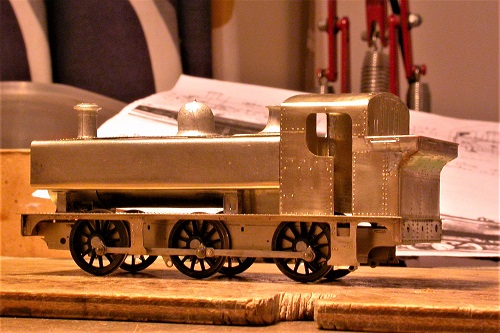 A basic running loco
A basic running loco
The biggest hurdle was not only getting the smokebox, boiler, firebox and panniers to fit together, but making them dimensionally accurate with respect to the cab and footplate. And getting the panniers to sit down nicely on their support brackets.
Two blind lead bolts fasten the cab front to the panniers, and a bolt goes up through the footplate, through the smokebox saddle and the smokebox into the boiler tube. The holes were elongated to allow the necessary adjustment. Daylight under the boiler was achieved without cutting the boiler, thanks to the High Level gearbox.
As I expected the bunker proved to be the most difficult part to make.
 Cab sub-assembly
Cab sub-assembly
The bunker/cab join is in line with the bunker’s top edge, as with the prototype. A couple of weeks before starting 1649, I studied and photographed 4110 on the West Somerset Railway to see how the GWR went about things. However, as with so many things in life, to make a bunker you first have to make a bunker. At least I know how to do a better job next time, and I will certainly have another go.
From here on, it’s a question of adding detail as and when the mood takes me, hopefully in time for exhibition. And now for something completely different.
Read Full Post | Make a Comment ( 1 so far )Continuous 1649 Development
The main body parts, with the exception of the bunker, are now fretted out, riveted and formed.
 “Panniers do maketh the tank”
“Panniers do maketh the tank”
The small section of pannier (bottom left) is the original trial forming piece and now acts as a jig to produce the end blanking plates and internal formers of the two full-length panniers. The smokebox is soldered up and is a sliding fit on the boiler, which is held in shape by twists of silver plated copper wire.
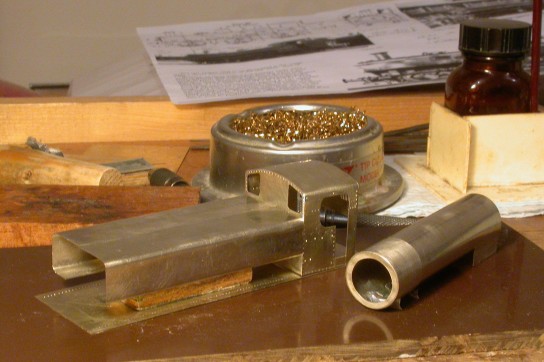 Trial assembly
Trial assembly
The boiler seams are now soldered and the panniers are bolted to the cab. After trimming the internal pannier formers so the boiler can slide through and bolt to the cab, the pannier front plates can be fretted to size and soldered in.
Then it’s a question of checking the fit and confirming the main measurements. At some stage I will have to tackle the bunker, but not yet.
Read Full Post | Make a Comment ( None so far )GWR(BR) 1649 Pannier Tank
I’ve picked up the Dornoch branch engine project again.
In 2014 I rolled a trial section of boiler and bent up a test length of the pannier tanks in my then new Vee block. This time I’m hoping to make a basic, running loco before running out of steam.
 All riveted and good to go
All riveted and good to go
The scratch body with Nu-Cast whitemetal castings will sit on a Branchlines kit chassis. Having a ready-made set of frames was a boost and I made (for me) rapid progress on the footplate sub-assembly.
After a chat with Chris Gibbon of High Level I chose a LoLoader 68:1 gearbox, which I will try out with a 1990s high-revving Mashima open frame motor from the old MRJ Manning Wardle project. The small wheels of 1649 and low footplate, with the rear axle 4mm behind the cab front, may mean some surgery later.
The main objective in this first week was to design a kit of body parts, which meant filling in the gaps in my understanding of how the real thing was put together. The preserved 1638 has been well photographed and I soon found a couple of photos showing the plate work joining the two pannier tanks over the boiler. These nicely complement the photographs and drawings I was given when starting the project (thanks, Ian).
Read Full Post | Make a Comment ( 1 so far )Kyle of Sutherland Mk 3

Over four years since it was last operated at a public event and the presentation of the latest Kyle of Sutherland is now very different. Here’s a preview of the extended diorama, which will be seen at Railex 2018, being tested at a local event on Saturday.
Proceeds for the event are going to RVS (Royal Voluntary Service), formerly WRVS.
Read Full Post | Make a Comment ( 1 so far )Culrain Trains
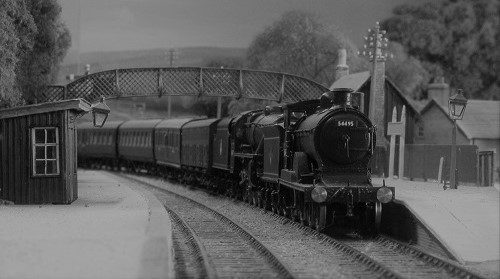 06.40 Inverness-Wick/Thurso
06.40 Inverness-Wick/Thurso
Taking a break from work on the lighting for Kyle of Sutherland, I updated one of my early train pictures. The first north-bound passenger of the day is calling at Culrain about nine-fifteen sometime in 1958, on what looks like a hazy start to the day.
This lengthy train includes several parcels vehicles, and the ex-GWR Siphon G was not unusual at this time (thanks Allan and Roger for the loan of this vehicle). Page 155 of Gavin Morrison’s book “Scottish Railways Then and Now” shows a similar train entering Brora in 1957.
Read Full Post | Make a Comment ( None so far )Culrain Trains
 06.40 Inverness-Wick/Thurso
06.40 Inverness-Wick/Thurso
Taking a break from work on the lighting for Kyle of Sutherland, I updated one of my early train pictures. The first north-bound passenger of the day is calling at Culrain about nine-fifteen sometime in 1958, on what looks like a hazy start to the day.
This lengthy train includes several parcels vehicles, and the ex-GWR Siphon G was not unusual at this time (thanks Allan and Roger for the loan of this vehicle). C.J.Gammell’s book “Then and Now” shows on page 155 a similar train entering Brora in 1957.
Read Full Post | Make a Comment ( None so far )Push-Pull Train Development

54495 drew its five coach train forward from the south cassette until the rear coach was alongside the platform, and after a suitable interval slowly moved off onto the north cassette. It then reversed the procedure, several times. Each time it negotiated the transition from cassette track to layout track, and vice versa, and also the reverse curves of the loop point. And at various speeds.
Of course, this was to test a new engine. I started out with a target of only two coaches for a 4-4-0, thinking that was the minimum I could get away with at exhibition. After running in over several days its pulling (and pushing) power continued to increase. Similarly with 54458. The locos now weigh around 200 gm each, and the tenders a further 80 gm. The weight was distributed so the locos balanced horizontally about half way along their length, slightly ahead of the leading driver axle. The bogies have side control springing and take their proper share of the load.
That was only half the job. The train consists of four Hornby coaches, converted to P4, and a hand built TPO. The back-to-back measurements were carefully checked, and re-checked, and the wheels were accurately centred with respect to the axle pin-points before I could get them all to turn freely.
Read Full Post | Make a Comment ( None so far )« Previous Entries


